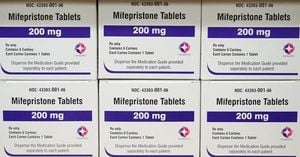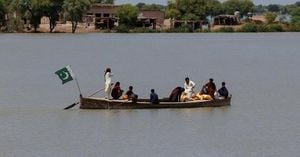Delhi continues to grapple with alarming levels of air pollution, maintaining its position within the "very poor" air quality category for six consecutive days. The Air Quality Index (AQI) recorded at 332 on Friday morning has raised health concerns for millions living not only in the capital but also across the National Capital Region (NCR).
The situation is dire across various NCR cities, with Greater Noida coming in at 272, Ghaziabad at 258, Noida at 249, Gurugram at 258, and Faridabad lagging at 166. These measurements indicate unhealthy air quality, which poses severe health risks, particularly to vulnerable groups including children, the elderly, and those with existing respiratory or cardiovascular conditions.
According to the Central Pollution Control Board (CPCB), the AQI scales delineate several categories of air quality:
- 0-50: Good
- 51-100: Satisfactory
- 101-200: Moderate
- 201-300: Poor
- 301-400: Very Poor
- 401-450: Severe
- Above 450: Severe Plus
With Delhi's AQI perched at 332, residents are exposed to significant health hazards, which can manifest as breathing difficulties, eye irritation, and exacerbation of pre-existing conditions like chronic obstructive pulmonary disease (COPD) and heart diseases. Reports indicate the severity of the weather is heightening the crisis, as Delhi experienced its coldest night this season with temperatures plummeting to 10.1 degrees Celsius, according to the India Meteorological Department (IMD). Cold weather naturally traps pollutants near the surface, intensifying the already poor air quality.
Taking cognizance of this persistent pollution crisis, the Supreme Court of India has mandated the continuing enforcement of Graded Response Action Plan (GRAP)-IV measures—barring specific directives related to schools—until its next review on December 2. The court has underscored the need for strict adherence to these guidelines, admonishing officials for any lapses and indicating potential repercussions for non-compliance.
Although physical classes have been allowed to proceed, the Supreme Court has reiterated the need to uphold restrictions under GRAP-2 and GRAP-3 until there's consistent improvement recorded in AQI levels. The measures are multifaceted and include bans on non-essential trucks—those transporting goods deemed non-essential or which operate on fuels more pollutive than LNG, CNG, or BS-VI diesel—restricted construction activities, and multiple traffic regulations intended to mitigate pollution sources.
Among GRAP-4 protocols are:
- A ban on entry for non-essential trucks, allowing only those carrying necessary goods or utilizing cleaner fuels.
- A halt on construction projects for public infrastructure to minimize dust and particulate matter release.
- Close monitoring of industrial emissions from local factories and stringent controls imposed where violations are recognized.
The Supreme Court included provisions aimed at protecting the livelihoods of construction workers affected by the construction suspension by instructing state governments to utilize the collected labour cess for their benefit. This measure acknowledges the economic strain the pollution control measures would otherwise inflict on workers whose livelihoods depend on construction activity.
Local authorities are taking additional steps to alleviate the pollution situation. Rapid response strategies are being put forth; for example, the introduction of truck-mounted water sprinklers is set to help mitigate pollution impacts directly within the National Capital Region. The Commission for Air Quality Management (CAQM) has expanded these discussions, confirming their recent stocktaking of current enforcement actions and GRAP implementations during their emergency meetings.
Importantly, the Supreme Court's recent interventions highlight the broader concerns surrounding air quality management and the dire need for immediate action. It has become increasingly evident through various reports and observations by citizens and health experts alike, the worsening pollution directly correlates with increasing public health crises.
Despite these measures and legal reinforcements, as pollution levels remain alarmingly high, the inhabitants of Delhi are advised to take necessary precautions to protect their health. Limited outdoor activity, use of air purifiers indoors, and adhering to health advisories have become recommendations of necessity.
The situation remains fluid, and whilst numerous measures are now attempting to get the pollution crisis under control, the effectiveness and enduring change will rely on sustained efforts and cooperation from all stakeholders. With contentious discussions around stubble burning also surfacing, the coming weeks could prove pivotal in determining the effectiveness of these pollution mitigating measures.
Delhi's air quality, which continues to remain at 'very poor' levels, has informed citizens’ calls for stricter enforcement of anti-pollution measures. While GRAP-4 plans are now firmly instituted, with utilities like schools experiencing regulations tweaked to allow some leniency, the continuous stream of data emphasizing the severe health impacts underlines the pressing atmosphere. At the heart of this crisis, everyone is effectively drawn together as advocates for healthier air.



